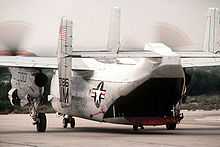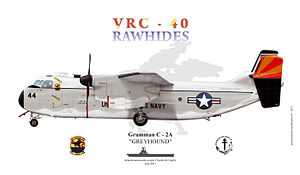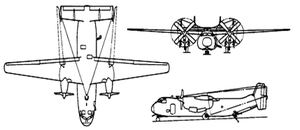Grumman C-2 Greyhound
The Grumman C-2 Greyhound is a twin-engine, high-wing cargo aircraft, designed to carry supplies and mail to and from aircraft carriers of the United States Navy. Its primary mission is carrier onboard delivery (COD). The aircraft provides critical logistics support to carrier strike groups. The aircraft is mainly used to transport high-priority cargo, mail and passengers between carriers and shore bases, and can also deliver cargo like jet engines and special stores.
Prototype C-2s first flew in 1964 and production followed the next year. The initial Greyhound aircraft were overhauled in 1973. More C-2s were ordered in the 1980s. Further improvements to the C-2 have followed.
Design and development
The C-2 Greyhound, a derivative of the E-2 Hawkeye, shares wings and power plants with the E-2, but has a widened fuselage with a rear loading ramp. The first of two prototypes flew in 1964. After successful testing, Grumman began production of the aircraft in 1965. The C-2 replaced the piston-engined Grumman C-1 Trader in the COD role. The original C-2A aircraft were overhauled to extend their operational life in 1973.

Powered by two Allison T56 turboprop engines, the C-2A can deliver up to 10,000 pounds (4,500 kg) of cargo, passengers or both. It can also carry litter patients in medical evacuation missions. A cage system or transport stand restrains cargo during carrier launch and landing. The large aft cargo ramp and door and a powered winch allow straight-in rear cargo loading and unloading for fast turnaround. The Greyhound's ability to airdrop supplies and personnel, fold its wings, and generate power for engine starting and other uses provide an operational versatility found in no other cargo aircraft.
The aircraft has four vertical stabilizers because of aircraft carrier hangar deck height restrictions. Only three of these stabilizers have working rudders.[citation needed] For adequate directional control of an aircraft of this size, a single rudder would have been too tall. It also places the outboard rudder surfaces directly in line with the propeller wash, providing effective yaw control down to low airspeeds, as during takeoff and landing.
In 1984, the Navy ordered 39 new C-2A aircraft to replace older airframes. Dubbed the Reprocured C-2A (C-2A(R)) due to the similarity to the original, the new aircraft has airframe improvements and better avionics. The older C-2As were phased out in 1987, and the last of the new models was delivered in 1990.
Upgrades

The 36 C-2A(R)s are undergoing a critical Service Life Extension Program (SLEP). The lifespan of the C-2A(R) was 10,000 hours, or 15,000 carrier landings; current plans require the C-2A to perform its mission supporting battle group operational readiness through 2015. The landing limit is quickly approaching for most of the airframes, and the SLEP will increase the Greyhound's projected life to 15,000 hours or 36,000 landings. Once the program is complete, it will allow the current 36 aircraft to operate until 2027. The SLEP includes structural improvements to the center wing, navigational upgrades including the addition of GPS and the dual CAINS II Navigation System, the addition of crash survivable flight incident recorders, and a Ground Proximity Warning System. The first upgraded C-2A(R) left NAVAIR Depot North Island on 12 September 2005, after sitting on the ground for three and a half years while the SLEP was developed and installed. A second airframe is currently nearing completion and it is anticipated that the remaining 34 aircraft will all undergo the SLEP upgrade within the next five years as operations and schedule permit. The eight-bladed NP2000 propeller is another part of this upgrade and is expected to be installed by 2010.[2]
In November 2008, the company also obtained a $37M contract for the maintenance, logistics and aviation administration services over five years for the C-2A fleet assigned to VX-20 test and evaluation squadron at Patuxent River. Northrop Grumman is currently working on an upgraded C-2 version, and has offered to modernize the fleet with components common to the E-2D Hawkeye.[3]
The C-2 Greyhound is competing with the V-22 Osprey for use as the future Carrier Onboard Delivery aircraft. Northrop Grumman has proposed modernizing the C-2 rather than replacing them with the Osprey. The proposal is to give the Greyhounds the same wings, glass cockpit, and engines as the E-2D Advanced Hawkeye in two phases. The first would replace the engines and avionics, and the second would replace the wing structures. Installing the Rolls Royce T56-427A engines would cut fuel consumption by 13-15 percent with the same 8-bladed propeller. Having the same cockpit as the E-2D would deliver a 10 percent savings on integrated logistics support over the life of the airplane. With the new engines, the C-2 would be able to take off with a 10,000 lb payload in 125 degree heat and fly in excess of 1,400 nmi (1,600 mi). Similar performance by the C-2A would require engine temperatures at 70 degrees F, with higher temperatures requiring trading fuel for payload. One of the Greyhound's most important features is its internal volume of 860 cubic feet of cargo space.[4]
Operational history

Between November 1985 and February 1987, VR-24 (the former Navy Transport Squadron) and its seven reprocured C-2As demonstrated the aircraft's exceptional operational readiness. The squadron delivered 2,000,000 pounds (910 t) of cargo, 2,000,000 pounds (910 t) of mail and 14,000 passengers in the European and Mediterranean theaters. The C-2A(R) also served the carrier battle groups during Operations Desert Shield and Desert Storm during the Gulf War, as well as Operation Enduring Freedom during the War in Afghanistan.
The Common Support Aircraft was once considered as a replacement for the C-2, but failed to materialize. Currently, there are no plans to replace the C-2A(R) fleet, and there are no replacement aircraft in development. The USN was exploring a replacement for the C-2, including the V-22 Osprey as of September 2009.[5] A MV-22 refueled on board the USS Nimitz (CVN-68) on 6 October 2012 as part of an evaluation on the feasibility of it potentially replacing the C-2 for the carrier onboard delivery (COD) role.[6]
On 2 June 2011, the US Navy loaned two C-2A(R) Greyhounds from VRC-40 (USN BuNos 162143 & 162165) to the French Navy. The two aircraft were stationed at Toulon-Hyères Airport, Hyères to assist in improving the flow of logistics and supplies to the French aircraft carrier Charles de Gaulle operating in the Mediterranean Sea off Libya in support of the NATO intervention in Libya. After 16 days, both aircraft returned to the US via Shannon Airport, Ireland on 18 June 2011.[7]
Variants

- YC-2A
- Prototype, two converted from E-2A Hawkeyes with redesigned fuselage.
- C-2A
- Production variant, 17 built.
- C-2A(R)
- "Reprocured" C-2A with improved systems based on the E-2C variant, 39 built.
Operators
Accidents
- On 29 April 1965, YC-2A #148147 ditched into Long Island Sound on a test flight, killing all 4 crewmen.[8]
- On 2 October 1969, C-2A #152796 from VRC-50 crashed in the Gulf of Tonkin en route from Naval Air Station Cubi Point to USS Constellation (CV-64), killing all 6 crew members and 23 passengers.[9]
- On 15 December 1970, C-2A #155120 from VRC-50 crashed shortly after launch from USS Ranger (CV-61), killing all 4 crew members and 5 passengers.[10]
- On 12 December 1971, C-2A #152793 crashed en route from Cubi Point to Tan Son Nhat International Airport, killing all 4 crew members and 6 passengers.[11]
- On 29 January 1972, C-2A #155122 crashed while attempting to land on the USS Independence (CV-62) in the Mediterranean Sea, killing both crewmen.[12]
- On 16 November 1973, C-2A #152787 crashed into the sea after takeoff from Chania International Airport, killing 7 of 10 persons on board.[13]
Specifications (Reprocured C-2A)

General characteristics
- Crew: 2 pilots, 2 aircrew
- Capacity: 26 passengers, 12 litter patients
- Payload: 10,000 lb (4,536 kg)
- Length: 56 ft 10 in (17.30 m)
- Wingspan: 80 ft 7 in (24.60 m)
- Height: 15 ft 10½ in (4.85 m)
- Wing area: 700 ft² (65 m²)
- Empty weight: 33,746 lb (15,310 kg)
- Loaded weight: 49,394 lb (22,405 kg)
- Useful load: 20,608 lb (9,350 kg)
- Max. takeoff weight: 60,000 lb (24,655 kg)
- Powerplant: 2 × Allison T56-A-425 turboprops, 4,600 shp (3,400 kW) each
Performance
- Maximum speed: 343 knots (394 mph, 635 km/h) at 12,000 ft (3,660 m)
- Cruise speed: 251 knots (289 mph, 465 km/h) at 28,700 ft (8,750 m)
- Stall speed: 82 knots (94 mph, 152 km/h) at idle power
- Range: 1,300 nm (1,496 mi, 2,400 km)
- Service ceiling: 33,500 ft (10,210 m)
- Rate of climb: 3,700 ft/min (at sea level) (13.3 m/s)
- Wing loading: 77.6 lb/ft² (378.9 kg/m²)
See also
- Related development
- Aircraft of comparable role, configuration and era
- Grumman C-1 Trader
- Lockheed US-3 Viking
References
- ↑ 1.0 1.1 "Navy Fact File". Navy.mil. 17 February 2009. Retrieved 10 September 2011.
- ↑ C-2A Greyhound Logistics Aircraft
- ↑ "Osprey Takes on Greyhound in Fight Over U.S. Navy’s COD."
- ↑ The Future COD Aircraft Contenders: The Northrop Grumman C-2A Greyhound - Defensemedianetwork.com, 3 August 2013
- ↑ Tilghman, Andrew (23 September 2009). "Navy eyes Ospreys as COD replacements". Navy Times. Retrieved 21 April 2010.
- ↑ Mass Communication Specialist 3rd Class Renee Candelario, USN (8 October 2012). "MV-22 Osprey Flight Operations Tested Aboard USS Nimitz". NNS121008-13. USS Nimitz Public Affairs. Retrieved 22 January 2013.
- ↑ "US Navy Loans Greyhounds to France". AirForces Monthly (Key Publishing), Issue 281, August 2011, p. 13. ISSN 09557091. Retrieved: 4 October 2011.
- ↑ "29 April 1965 Grumman C-2A Greyhound". aviation-safety.net. Retrieved 29 April 2013.
- ↑ "2 October 1969 Grumman C-2A Greyhound". aviation-safety.net. Retrieved 29 April 2013.
- ↑ "15 December 1970 Grumman C-2A Greyhound". aviation-safety.net. Retrieved 29 April 2013.
- ↑ "12 December 1971 Grumman C-2A Greyhound". aviation-safety.net. Retrieved 29 April 2013.
- ↑ "29 January 1972 Grumman C-2A Greyhound". aviation-safety.net. Retrieved 29 April 2013.
- ↑ "16 November 1973 Grumman C-2A Greyhound". aviation-safety.net. Retrieved 29 April 2013.
- ↑ NAVAIR (November 1984). "Performance Summary" (PDF). Standard Aircraft Characteristics, Reprocured C-2A. Retrieved 21 April 2010.
External links
| Wikimedia Commons has media related to C-2 Greyhound. |
| |||||||||||||||||||||||||||||||
| ||||||||||||||